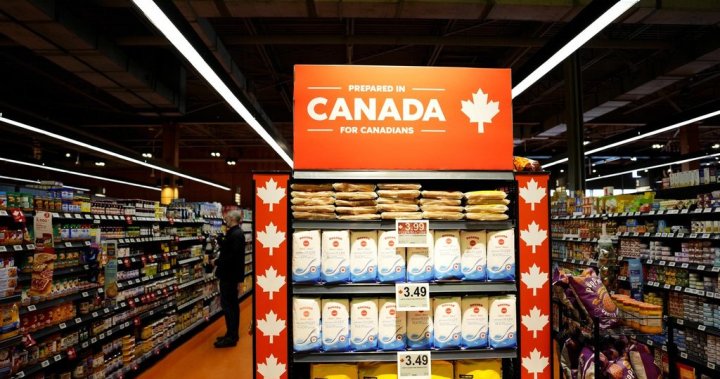As Canadians unfurled their maple leaf flags this past weekend, their shopping carts told a compelling economic story. Despite inflation pressures continuing to squeeze household budgets, consumers across the country demonstrated a remarkable commitment to supporting local businesses during Canada Day celebrations.
The “shop local” movement isn’t just patriotic sentiment—it’s becoming a defining economic pattern with significant implications for our national retail landscape. According to data from Square Canada, small business transactions jumped 18% during the week leading to July 1st compared to regular summer weekends, with particularly strong showings in artisanal food, craft beverages, and locally-made apparel.
“We’re seeing what I’d call ‘values-based spending’ emerge as a counterforce to inflation anxiety,” explains Corinne Pohlmann, Senior Vice President at the Canadian Federation of Independent Business. “Consumers are making deliberate choices about where their dollars go, even when those dollars don’t stretch as far as they used to.”
This trend appears particularly pronounced during patriotic holidays, when the emotional connection to community businesses strengthens. In Toronto’s Kensington Market, foot traffic increased nearly 30% over the holiday weekend, with many shoppers specifically mentioning “supporting Canadian businesses” as their motivation for braving the crowds.
The economics behind this behavior are more complex than simple patriotism. Research from Retail Council of Canada suggests that 67% of consumers now research a product’s origin before purchasing, up from 42% in pre-pandemic surveys. This represents a fundamental shift in how Canadians approach consumption—one that may have lasting consequences for both multinational corporations and local enterprises.
Local spending also creates what economists call the “multiplier effect.” For every dollar spent at a local business, approximately 63-75 cents remains in the local economy, compared to about 43 cents for non-local retailers. This economic ripple generates community resilience that many consumers now prioritize alongside personal financial considerations.
“People increasingly understand that spending locally isn’t charity—it’s investing in your own economic ecosystem,” notes Diane Brisebois, President of the Retail Council of Canada. “That awareness has accelerated dramatically since 2020.”
The data reveals interesting regional variations. Atlantic Canada showed the strongest local shopping preference this Canada Day, with New Brunswick reporting a 24% increase in local business transactions. Meanwhile, Alberta and Saskatchewan demonstrated more modest but still significant increases of 12% and 14% respectively.
The technology enabling this shift deserves attention. Point-of-sale systems that highlight Canadian-made products, apps that map local businesses, and digital payment platforms that simplify transactions for small vendors have all contributed to making local shopping more convenient. Square Canada reports that contactless payments at local businesses increased 43% year-over-year, suggesting that technological friction is no longer a barrier to choosing local options.
Behind these statistics are real business owners feeling the impact. “Three years ago, Canada Day was just another weekend for us. Now it’s circled on our calendar as a crucial revenue opportunity,” explains Priya Sharma, who owns a small bath and body products company in Vancouver. “We see customers specifically seeking Canadian-made gifts and mentioning that they’re choosing us over larger chains.”
The trend extends beyond retail into services and experiences. Bookings for local tours, cooking classes, and artisan workshops saw a 32% increase during the holiday weekend according to Tourism Industry Association of Canada data. Many of these experiences explicitly marketed their Canadian connections and local economic impact.
This shift hasn’t gone unnoticed by larger corporations, many of which are now highlighting their Canadian suppliers, employees, and community investments. Major retailers including Loblaws and Canadian Tire significantly expanded their “Canadian-made” sections ahead of July 1st, recognizing the purchasing power of patriotic sentiment.
However, the “shop local” movement faces significant headwinds. Inflation continues to erode purchasing power, with grocery prices up 2.2% year-over-year according to the latest Statistics Canada figures. This creates tension between values and value—consumers want to support local businesses but must stretch their dollars further than before.
“We’re definitely seeing consumers make calculated trade-offs,” explains Dr. Frances Chen, consumer behavior researcher at UBC. “They might choose local for certain symbolic or visible purchases like gifts or holiday items, while economizing elsewhere.”
The implications for Canadian business owners extend beyond seasonal spikes. The question remains whether this represents a fundamental realignment of consumer priorities or merely a temporary response to economic uncertainty and supply chain disruptions.
My analysis suggests we’re witnessing something more durable than seasonal patriotism. The data shows that younger consumers in particular are integrating community impact into their purchasing decisions in ways previous generations did not. Gen Z and Millennial shoppers report considering a product’s community impact “always” or “often” at rates 24% higher than Baby Boomers, according to RCC research.
For businesses navigating this landscape, the message is clear: local connections matter more than ever, but they must be authentic. Companies perceived as “local-washing”—superficially claiming local credentials without substantive community investment—face increasingly sophisticated consumer skepticism.
As we pack away the Canada Day decorations for another year, the economic patterns revealed during the holiday provide a window into evolving consumer priorities. In a time of economic pressure, many Canadians are choosing to vote with their wallets for local resilience—a trend that may reshape our economic landscape long after the fireworks fade.






